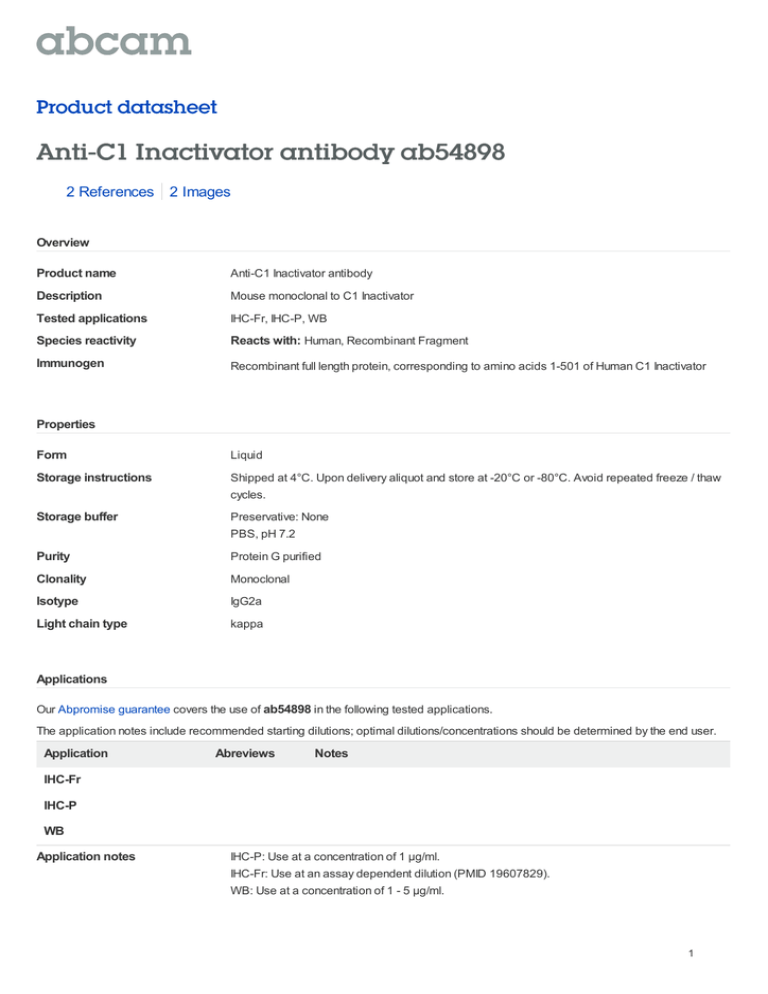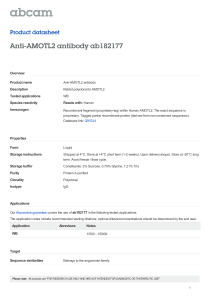Anti-C1 Inactivator antibody ab54898 Product datasheet 2 References 2 Images
advertisement

Product datasheet Anti-C1 Inactivator antibody ab54898 2 References 2 Images Overview Product name Anti-C1 Inactivator antibody Description Mouse monoclonal to C1 Inactivator Tested applications IHC-Fr, IHC-P, WB Species reactivity Reacts with: Human, Recombinant Fragment Immunogen Recombinant full length protein, corresponding to amino acids 1-501 of Human C1 Inactivator Properties Form Liquid Storage instructions Shipped at 4°C. Upon delivery aliquot and store at -20°C or -80°C. Avoid repeated freeze / thaw cycles. Storage buffer Preservative: None PBS, pH 7.2 Purity Protein G purified Clonality Monoclonal Isotype IgG2a Light chain type kappa Applications Our Abpromise guarantee covers the use of ab54898 in the following tested applications. The application notes include recommended starting dilutions; optimal dilutions/concentrations should be determined by the end user. Application Abreviews Notes IHC-Fr IHC-P WB Application notes IHC-P: Use at a concentration of 1 µg/ml. IHC-Fr: Use at an assay dependent dilution (PMID 19607829). WB: Use at a concentration of 1 - 5 µg/ml. 1 Not yet tested in other applications. Optimal dilutions/concentrations should be determined by the end user. Target Function Activation of the C1 complex is under control of the C1-inhibitor. It forms a proteolytically inactive stoichiometric complex with the C1r or C1s proteases. May play a potentially crucial role in regulating important physiological pathways including complement activation, blood coagulation, fibrinolysis and the generation of kinins. Very efficient inhibitor of FXIIa. Inhibits chymotrypsin and kallikrein. Involvement in disease Defects in SERPING1 are the cause of hereditary angioedema (HAE) [MIM:106100]; also called hereditary angioneurotic edema (HANE). HAE is an autosomal dominant disorder characterized by episodic local subcutaneous edema and submucosal edema involving the upper respiratory and gastrointestinal tracts. HAE due to C1 esterase inhibitor deficiency is comprised of two clinically indistinguishable forms. In HAE type 1, representing 85% of patients, serum levels of C1 esterase inhibitor are less than 35% of normal. In HAE type 2, the levels are normal or elevated, but the protein is non-functional. Sequence similarities Belongs to the serpin family. Post-translational modifications Highly glycosylated (49%) with N- and O-glycosylation. Can be proteolytically cleaved by E.coli stcE. Cellular localization Secreted. Anti-C1 Inactivator antibody images C1 Inactivator antibody (ab54898) used in immunohistochemistry at 1ug/ml on formalin fixed and paraffin embedded human kidney. IHC-P - C1 Inactivator antibody (ab54898) Western blot against tagged recombinant protein immunogen using ab54898 C1 Inactivator antibody at 1ug/ml. Predicted band size of immunogen is 81 kDa Western blot - C1 Inactivator antibody (ab54898) Please note: All products are "FOR RESEARCH USE ONLY AND ARE NOT INTENDED FOR DIAGNOSTIC OR THERAPEUTIC USE" 2 Our Abpromise to you: Quality guaranteed and expert technical support Replacement or refund for products not performing as stated on the datasheet Valid for 12 months from date of delivery Response to your inquiry within 24 hours We provide support in Chinese, English, French, German, Japanese and Spanish Extensive multi-media technical resources to help you We investigate all quality concerns to ensure our products perform to the highest standards If the product does not perform as described on this datasheet, we will offer a refund or replacement. For full details of the Abpromise, please visit http://www.abcam.com/abpromise or contact our technical team. Terms and conditions Guarantee only valid for products bought direct from Abcam or one of our authorized distributors 3
![Anti-C1 Inactivator antibody [EPR8016] ab134915 Product datasheet 2 Images Overview](http://s2.studylib.net/store/data/012488282_1-9fffefe2aa6c8be329a2fb9b7d8520c6-300x300.png)
